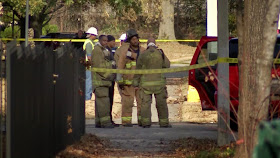November 25, 2014
MEMPHIS, TN — Five utility workers have been injured in a gas line explosion and fire in Memphis.
Fire Department spokesman Wayne Cooke says three Memphis Light, Gas & Water workers suffered critical wounds, and two others had less severe injuries. He said the workers were called out to a residential area on Tuesday morning to fix a gas leak and were working on it when the line exploded and caught fire.
Four workers suffered burns, three of whom were hospitalized in critical condition, Cooke said. A worker with minor burns and a worker who went into shock were treated and released from the hospital.
Firefighters were able to extinguish the blaze.
Police say no evacuation was ordered because the incident was contained. The underground line was located along a street.
Memphis Light, Gas and Water spokesman Richard Thompson said the company was investigating the cause.
“I believe there was a spark and it led to an explosion," Thompson said. "What exactly happened, we are still trying to determine.”
________________________________________________________________
5
MLGW workers injured in gas line fire
SHELBY COUNTY, TN (WMC) -
Five MLGW workers were taken to the
hospital after a gas line exploded on Winterpark Drive near Margaux Cove.
Three people are in critical
condition; two others were taken to the hospital in non-critical condition,
according to Memphis Fire Department.
The workers were repairing a 2 1/2
inch underground gas line when it exploded, sending flames out of the manhole.
"Quite bad, kinda
horrific," said Randy Smith, who lives five houses down from where it
happened. "There was actually guys down in the hole. One of the MLGW
workers, he was attempting to pull one of his coworkers out the hole. At the
same time, there was another trying to crawl himself out the hole."
Even though houses on the street
were not damaged and nobody living nearby was injured, it was a scene that
neighbors will never forget.
"This really was a bad sight,”
Smith said. “I hate I saw that. I mean, it's not every day you see grown men
crying and calling for their mamas. My thoughts and prayers go out to their
family."
___________________________________________________________________________
MLGW
Workers Injured In Gas Line Explosion In Hickory Hill
(VIDEO) Shock, flames, and cries of pain. That is what neighbors witnessed after a gas line explosion in Hickory Hill. Five MLGW workers were hurt in the blast on Winter Park Drive Tuesday morning.
(VIDEO) Shock, flames, and cries of pain. That is what neighbors witnessed after a gas line explosion in Hickory Hill. Five MLGW workers were hurt in the blast on Winter Park Drive Tuesday morning.
They were
working on an underground gas line when something went wrong. "They were
working to repair a 2.5 inch underground gas line," said Lt. Wayne Cooke
of the Memphis Fire Department. Witnesses came running to see what exactly
happened. They said they could hear the victims' screams from several yards
away. "We saw the three guys they were pulling out of the hole. It was
terrible, it was bad," said witness Sylvester Whitaker.
"It was
pretty bad. We had guys really burning, on fire, crying, calling mom, calling
loved ones. Just a bad situation all around," said witness Randy Smith.
Memphis firefighters are investigating what caused the explosion. Officials
with MLGW said the work being done by the crew isn't unusual. "I know they
were employees who were doing their job, and basically, who do this kind of
work every day. But they are trained. They are experienced. If they weren't,
they wouldn't be doing their job," said MLGW spokesperson Gale Jones
Carson.
But for those in the Hickory Hill neighborhood, it was something they
all will never forget. Two of the MLGW workers have been released from the
hospital. Three others are still being treated. All three are suffering from
burns. Two of the workers are in critical condition. We are told the third is
not as badly injured, but we don't know his condition. Family members said
Sedric Fields was one of the men hurt. They said he has serious burns. He is
awake and talking to doctors, but as of an hour ago his family has not been
able to see him.




